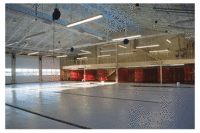In many parts of the U.S., the summer of 2013 was a banner season for solar energy collection.
Many solar thermal systems, especially those in the over-baked western part of the country, undoubtedly collected enough heat that they reached the upper temperature limit of the storage tank and had to dump excess heat. Indeed, someone judging the performance of solar thermal systems under such conditions might be inclined to think that supply far outpaces demand.
If only this were the case in winter. But as anyone with a solar thermal system in a challenging winter climate knows, you definitely need a backup heat source during much of the winter doldrums.
In my area, firewood is plentiful and relatively inexpensive. You can buy all you want for about $65/face cord, delivered. At a nominal 80% conversion efficiency in a wood-gasification boiler, that works out to about $11.18 per million Btu delivered. In rural areas of the Northeast, the primary heating fuel is #2 fuel oil and propane. The current price for #2 oil is about $3.60 per gal. At 85% conversion efficiency, that works out to $30.24 per million Btu delivered — almost three times as much as heat provided by a wood-gasification boiler.
The plentiful supply and relatively low cost of firewood in the Northeast in combination with the high cost of conventional fuels has generated strong interest in using wood for central heating. State-of-the-art wood-gasification boilers are a great way to efficiently convert fire wood into heated water. After that, modern hydronics technology offers many ways to store and distribute that energy for both space heating and domestic hot water.
Still, most people I know don’t want to maintain operation of a wood-gasification boiler in summer when the typical load is domestic water heating.
So if solar heat generation is ideal for the summer while wood-based heating makes sense for colder and cloudier weather, why not link these two systems to a common storage and distribution system? Hydronics technology makes this possible.
Two into one
Figure 1(shown above) shows one way to combine a wood-gasification boiler and solar thermal array into a common system.
The two heat sources are linked at the storage tank. Either one can operate independently of the other. It’s likely that the boiler will not be stoked up if the owner is expecting a period of significant solar gain. However, if the boiler is operating and the sun comes out, the collector array can still operate provided the collector temperature rises several degrees above the storage tank temperature.
The solar subsystem is a closed loop filled with an antifreeze solution. Heat is transferred to the system water using a generously sized brazed-plate heat exchanger. The circulator between the storage tank and lower temperature size of the heat exchanger includes a check valve. This prevents heat migration into the solar subsystem when it is not operating. The collector array circulator also includes a check valve to further guard against heat migration.
A thermostatically controlled “loading unit” is installed near the inlet to the wood-gasification boiler. This device consists of a circulator, thermostatic mixing valve and flapper-type check valve. Its purpose is to prevent internal flue gas condensation (which creates creosote) within the combustion chamber. When the circulator in the loading unit is operating, the pressure differential it creates forces the flapper-type check valve to remain closed. The internal thermostatic element regulates the proportions of how water from the boiler outlet and cooler water from the storage tank are blended to keep the boiler inlet temperature suitably high (typically above 130° F for 20% moisture content firewood).
During a power failure, the flapper-type check mechanism in the loading unit allows natural convection flow between the boiler and thermal storage tank. In consideration of this, the path between the boiler and storage tank should have low-flow resistance. The check valve seen on the supply pipe from the boiler to the storage tank must be a flapper-type check valve. Never use a weighted plug flow check or spring-loaded check valve in this location. They create too much resistance to buoyancy-driven flow.
The space heat distribution system could use one or more types of low temperature heat emitters. Good choices include radiant floor, wall, or ceiling panels, or panel radiators. I suggest all heat emitters be selected so that the system can deliver full design load output without exceeding a supply water temperature of 120°. Even lower supply water temperatures are better if possible with large surface area radiant panels. The lower the supply water temperature the lower the temperature at which the storage tank can supply heat. This will increase the efficiency of the solar collectors and also lengthen the time between boiler firings
Sidearm domestic
Domestic water is preheated by an external stainless-steel heat exchanger as shown in Figure 2 (pictured above).
The domestic water flow switch closes whenever it detects a demand of 0.6 gpm or more. This turns on a small circulator, which moves system water from the storage tank through the primary side of the heat exchanger. Domestic cold water passes through the other side of the heat exchanger. Its temperature rise depends on the water temperature within the storage tank. If the tank is 130° or higher and the target domestic water delivery temperature is 120° or lower, a suitably sized heat exchanger could provide the full temperature rise. If the storage tank is cooler, the heat exchanger provides preheating. A thermostatically controlled electric tankless water heater adjusts the input wattage to its element to “top off” the temperature rise as required.
It also may be possible to piggyback a signal from the element contactor in the tankless electric water heater to determine when the domestic water flow rate reaches the turn-on threshold of the heater. This would eliminate the need for the external flow switch described above. The piggyback signal would likely be at 240 VAC. This could be used to operate a relay if a standard 120 VAC circulator is used between the storage tank and heat exchanger. Be sure to check with the manufacturer of the tankless unit to verify if this is possible and within the warranty constraints of the unit.
Also keep in mind tankless electric water heaters have a high-limit safety device that opens the element circuit if the incoming water temperature exceeds a set upper limit (i.e.130°). Some units require a manual reset when this happens. Others will automatically reset but only when the incoming water temperature drops to around 70°. Some units can be ordered with an optional 180° upper limit. These would be appropriate in systems where the thermal storage tank, under the right conditions, could cause the water leaving the heat exchanger to be above the 130° setting.
This type of approach leverages the strengths of both solar- and wood-fired boilers. It’s a good combination for clients who are committed to green energy, want to use state-of-the-art hardware and expect the unrivaled comfort delivered by a well-designed hydronic system.






